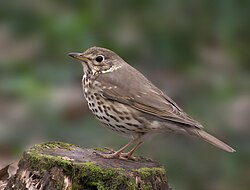Song thrush
The song thrush (usually thrush, Turdus philomelos) is a member of the passerine songbird family Turdidae. It breeds across much of Eurasia. It is also known in English dialects as throstle or mavis. The song thrush has brown upperparts and black-spotted cream or buff underparts, and has three recognised subspecies. Its distinctive song, which has repeated musical phrases, has frequently been referred to in poetry.
| Song thrush | |
|---|---|

| |
| Scientific classification | |
| Kingdom: | |
| Class: | |
| Order: | |
| Family: | |
| Genus: | Turdus
|
| Binomial name | |
| Turdus philomelos | |

| |
| Breeding range – yellow Winter range – blue Present all year – green | |




The song thrush breeds in forests, gardens and parks, and is partially migratory with many birds wintering in southern Europe, North Africa and the Middle East; it has also been introduced into New Zealand and Australia. Although it is not threatened globally, there have been serious population declines in parts of Europe, probably due to changes in farming practices.
The thrush builds a neat mud-lined cup nest in a bush or tree and lays four or five dark-spotted blue eggs. It is omnivorous and has the habit of using a favourite stone as an "anvil" on which to smash snails. Like other perching birds (passerines), it is affected by external and internal parasites and is vulnerable to predation by cats and birds of prey.
Breeding and survival
changeThe female song thrush builds a neat cup-shaped nest lined with mud and dry grass in a bush, tree or creeper, or, in the case of the Hebridean subspecies, on the ground. She lays four or five bright glossy blue eggs which are lightly spotted with black or purple. Two or three broods in a year is normal, although only one may be raised in the north of the range.[2] On average, 54.6% of British juveniles survive the first year of life, and the adult annual survival rate is 62.2%. The typical lifespan is three years, but the maximum recorded age is 10 years 8 months.[3]
The thrush is occasionally a host of parasitic cuckoos, but this is rare because the thrush usually recognizes the cuckoo's eggs.[4] However, the thrush does not act with the same aggression towards the adult cuckoo as does the blackbird.[5] The introduced birds in New Zealand, where the cuckoo does not occur, still have the ability to recognise and reject non-mimetic eggs.[6]
Feeding
changeThe song thrush is omnivorous, eating a wide range of invertebrates, especially earthworms and snails, as well as soft fruit and berries. Like its relative, the blackbird, the thrush finds prey by sight, has a run-and-stop hunting technique on open ground, and will rummage through leaf-litter seeking food.[2]
Snails are especially important when drought or hard weather makes it difficult to find other food. The thrush often uses a favourite stone as an "anvil" on which to smash the snail before extracting the soft body and invariably wiping it on the ground before eating it.[7] Young birds initially flick objects and attempt to play with them until they learn to use anvils as tools to smash snails.[8] The nestlings are mainly fed on animal food such as worms, slugs, snails and insect larvae.[2]
References
change- ↑ BirdLife International (2004). Turdus philomelos. 2006 IUCN Red List of Threatened Species. IUCN 2006. Retrieved on 12 May 2006. Database entry includes justification for why this species is of least concern
- ↑ 2.0 2.1 2.2 Clement, Peter; Hathway, Ren & Wilczur, Jan 2000. Thrushes. Helm Identification Guides, Christopher Helm, pp392–395. ISBN 0713639407
- ↑ "Song thrush Turdus philomelos [CL Brehm, 1831]". BTO Birdfacts. British Trust for Ornithology. Retrieved 2008-01-25.
- ↑ Davies, N.B. (2002). "Cuckoo tricks with eggs and chicks". British Birds. 95 (3): 101–115.
- ↑ Grim, Tomáŝ; Honza, Marcel (2001). "Differences in behaviour of closely related thrushes (Turdus philomelos and T. merula) to experimental parasitism by the common cuckoo Cuculus canorus" (PDF). Biologia, Bratislava. 56 (5): 549–556. Archived from the original (PDF) on 2017-08-09. Retrieved 2022-03-01.
- ↑ Hale, Katrina; Briskie, James V. (March 2007). "Response of introduced European birds in New Zealand to experimental brood parasitism". Journal of Avian Biology. 38 (2): 198–204. doi:10.1111/j.2007.0908-8857.03734.x.
- ↑ Snow, David & Perrins, Christopher M. (eds) 1998. The Birds of the Western Palearctic. Concise edition, 2 volumes. Oxford: Oxford University Press, p1225/1228. ISBN 0-19-854099-X
- ↑ Henty, C. J. (1986). "Development of snail-smashing by song thrushes". British Birds. 79: 277–281.

